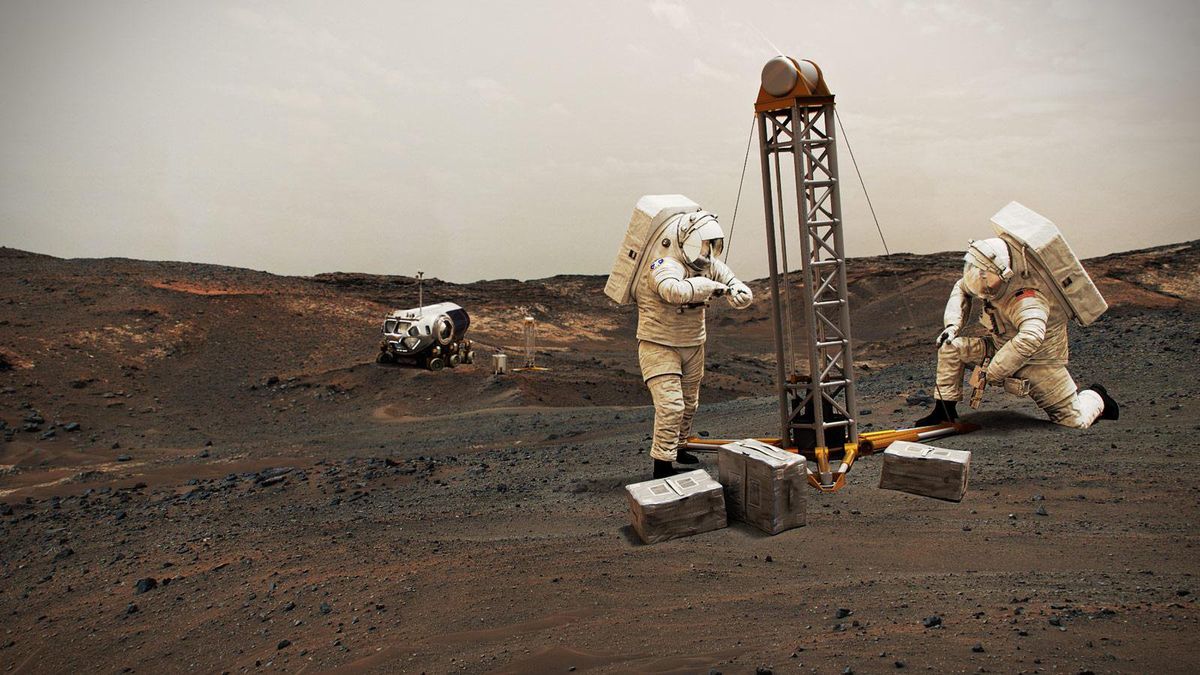Twenty years’ worth of imagery captured by two orbiters circling Mars has revealed raging winds on the red planet.
Wind on the barren planet would be invisible if it weren’t for Mars’ iconic red dust, which was caught in the wind’s vortices, creating a phenomenon known as dust devils.
These tornado-like whirlwinds also occur on Earth, but the new catalog of Martian dust devils, published Wednesday in the journal Science Advances, shows that Martian dust devils seem to move much faster and are more abundant on a global scale, said lead study author Dr. Valentin Bickel, a Center for Space and Habitability fellow at the University of Bern in Switzerland.
Researchers compiled the new publicly available catalog by using images taken by the European Space Agency’s Mars Express since 2004 and ExoMars Trace Gas Orbiter since 2016.
They trained a neural network, or machine learning modeled on the human brain, to spot the vortices in the orbital data, then checked each one to create a map of 1,039 dust devils across Mars, including examples atop ancient volcanoes and in open plains. The team was also able to determine the direction of motion for 373 of the rotating dust-filled wind columns.
They determined that the Martian dust devils and their accompanying winds can move as rapidly as about 99 miles per hour (160 kilometers per hour), much faster than any dust devils ever clocked by rovers exploring the red planet’s surface.
“This observation implies that those winds are likely able to lift a substantial amount of dust from the surface into the atmosphere,” Bickel wrote in an email. “We found a new puzzle piece that helps us to better understand the Martian dust cycle: where, when and how much dust is lifted off the surface and is injected into the atmosphere.”
Tracking the movement of dust on Mars is crucial for planning future robotic and human exploration of the red planet, experts say.
ExoMars Trace Gas Orbiter captured three dust devils tracking across the Martian surface on November 8, 2021. - ESA/TGO/CaSSIS
A window into whirlwinds
Studying dust on Mars provides scientists with a way to model the planet’s climate without actually being on the ground.
On Earth, rain helps clear dust from the air. But on Mars, dust can linger in the atmosphere for much longer once it’s lofted by wind, traveling across the entire planet.
And once dust is in the atmosphere, it affects Mars’ climate and weather. Dust prevents sunlight from reaching the surface, causing daytime temperatures to be cooler — and it insulates the planet to keep temperatures warmer at night.
Now, based on the new research, scientists suspect dust devils may play a larger role in lofting dust into the Martian air than previously thought.
Dust devils have long fascinated Bickel because they provide a window into the dynamics of Mars’ atmosphere closest to the planet’s surface — and they can be seen from orbit.
“I think it is incredible that we are able to observe and track moving whirlwinds of dust on a different planet,” Bickel said. “By observing dust devils from orbit we can learn many things, such as wind speed and direction, which would otherwise be invisible.”
The team’s analysis showed that while dust devils occurred across the planet, many were found in Amazonis Planitia, one of the smoothest plains on Mars that is covered with dust and sand.
Dust devils form when hot air near the surface rises and spins, picking up dust along the way, Bickel said.
“It appears that Amazonis Planitia offers the ideal conditions for dust devil formation, as it’s a vast, very flat region that receives a lot of illumination during the summer,” he said.
The team also determined that dust devils have seasonality, with intense whirlwind activity taking place during the spring and summer months in both the northern and southern hemispheres. Typically, the vortices just last a few minutes and occur during daytime, between 11 a.m. and 2 p.m. local time — similar to dust devils that occur in arid, dusty places on Earth in the summer.
An advantageous aerial view
Neither orbiter carries instruments that were designed to clock wind speeds on Mars. But Bickel and his team uncovered treasure within what might normally be thought of as a nuisance.
Both orbiters create images by combining views from different channels that look at Mars in specific colors or directions. For example, Mars Express can create a single image from nine image channels, and there can be delays of between seven and 19 seconds from one channel to another.
So if there is movement on Mars, like a dust devil, it produces noticeable “color offsets” in the final mosaic image — and a way to track the speed and motion of the dust devils.
“It’s great to see researchers using Mars Express and ExoMars (Trace Gas Orbiter) for totally unexpected research,” said Colin Wilson, ESA project scientist for both orbiters, in a statement. He was not involved in the study. “Dust affects everything on Mars — from local weather conditions to how well we can take images from orbit. It’s difficult to understate the importance of the dust cycle.”
Faster dust devils tend to travel in very straight lines, while slower dust devils wobble from left to right, Bickel said.
Previous measurements of dust devils on Mars showed that they typically had a sustained speed below 31 miles per hour (50 kilometers per hour), with a rare maximum of 62 miles per hour (100 kilometers per hour). But the latest data shows a much higher maximum for the dust devils as well as the winds surrounding them.
“These strong, straight-line winds are very likely to bring a considerable amount of dust into the Martian atmosphere — much more than previously assumed,” Bickel said. “Our data show where and when the winds on Mars seem to be strong enough to lift dust from the surface.”
But Mars’ atmosphere is more than 100 times thinner than Earth’s, meaning that even strong winds would feel more like a breeze to us. Without a substantial atmosphere, wind lacks force — but on Mars, it’s just enough to pick up dust.
“A dust devil would certainly not be able to kick you off your feet,” Bickel said.
The blurred motion of a dust devil can be seen dancing on Mars on December 3, 2021, through the Colour and Stereo Surface Imaging System on ExoMars Trace Gas Orbiter. - ESA/TGO/CaSSIS
Picking the perfect landing site
Based on their compiled database, the researchers estimate that dust devils lifted between 2,200 and 55,000 tons and 1,000 and 25,000 tons of dust into the northern and southern hemispheres of the Martian atmosphere, respectively, between 2004 and 2024.
The findings show that climate models for Mars have long underestimated the winds that drive the movement of sediment on the planet — information that is necessary to model past conditions on ancient Mars and determine how its surface has evolved over time, said Dr. Lori Fenton, senior research scientist in planetary science at the SETI Institute in California. Fenton was not involved in the new study.
“On Mars, the mobilization of sand and dust is one of the most important drivers of surface modification (through sediment deposition and erosion) and climate change (through the ever-changing atmospheric dust load),” Fenton wrote in an email.
Dust also remains a primary concern for missions heading to Mars. Suspended Martian dust can lead to planet-encircling dust storms, a phenomenon which ended the Opportunity mission in 2019. And a buildup of dust on the stationary lander InSight’s solar panels put an end to that mission in 2022.
Sometimes, dust devils can be helpful. By chance, the vortices helped clear dust from solar panels on the Spirit rover in 2009.
Bickel said that new images from orbital data will continue to be added to the catalog so it can serve as a resource for future mission planning.
“Our measurements could help scientists build up an understanding of wind conditions at a landing site before touchdown, which could help them estimate how much dust might settle on a rover’s solar panels — and therefore how often they should self-clean,” Bickel said.
A map shows dust devil activity during local spring and summer in Mars’ northern hemisphere (black and dark gray-blue dots and arrows) and southern hemisphere (light gray and pink dots and arrows). - ESA/TGO/CaSSIS
Data from the new study is already being used to help determine the optimal landing site for ESA’s ExoMars Rosalind Franklin rover, expected to touch down on Mars in 2030.
Dr. Ralph Lorenz, a planetary scientist at the Johns Hopkins University’s Applied Physics Laboratory, said it’s exciting to see a big picture of dust devils, phenomena that he considers to be among the most prominent and interesting features of the Martian atmosphere. Having a broad survey of them provides important context for future landing sites, said Lorenz, who did not participate in the new research.
“Until we understand (dust devils), solar power on Mars is always going to be somewhat ‘uncertain’ long-term, something particularly important as we look forward to humans on Mars in the not-too-distant future,” Lorenz wrote in an email.
The new observations could help validate and improve weather and climate models for Mars, which will ensure the safety, durability and longevity of future missions, said Dr. J. Michael Battalio, associate research scientist in the department of Earth and planetary sciences at Yale University. Battalio was not involved in the new study.
The results also highlight the value of having multiple long-term datasets from different Mars missions — something that is in jeopardy due to proposed NASA budget cuts, Battalio added. Studying Mars’ climate is also important for understanding Earth, he said.
“Mars’s unique conditions provide an independent laboratory for comparing to how Earth’s weather works to make sure we have the most complete, general formulation of atmospheric dynamics possible,” Battalio wrote in an email. “Studying the solar system broadly isn’t just about exploration, it helps us understand our home.”
Sign up for CNN’s Wonder Theory science newsletter. Explore the universe with news on fascinating discoveries, scientific advancements and more.
For more CNN news and newsletters create an account at CNN.com
.png)
 German (DE)
German (DE)  English (US)
English (US)  Spanish (ES)
Spanish (ES)  French (FR)
French (FR)  Hindi (IN)
Hindi (IN)  Italian (IT)
Italian (IT)  Russian (RU)
Russian (RU) 











Comments